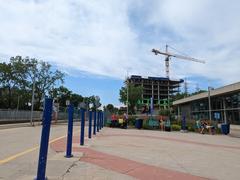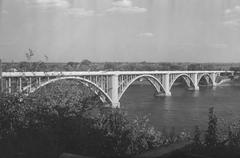Cartier Laval Canada Visiting Hours, Tickets, and Historical Sites Guide
Date: 03/07/2025
Introduction: Cartier Laval’s Unique Blend of Heritage and Modernity
Nestled within Laval, Quebec, the Cartier district is a vibrant destination where rich history meets contemporary urban life. From its deep Indigenous roots and French colonial legacy to its present status as a bustling community and transit hub, Cartier offers visitors an immersive journey through time. Highlights include architectural landmarks like the Maison André-Benjamin-Papineau, scenic green spaces such as Parc des Prairies, and dynamic cultural venues like Maison des Arts de Laval. With excellent accessibility via the Cartier Metro Station, visitors can seamlessly explore everything from local festivals and Quebecois cuisine to community events that showcase Laval’s multicultural spirit (overyourplace.com, tourismelaval.com, canadiantravelguide.net).
Table of Contents
- Early Settlement and Indigenous Roots
- French Colonial Era and Naming of Laval
- Municipal Development and Modern Laval
- Architectural Heritage and Notable Landmarks
- Cartier District: Urban Growth and Community Life
- Cultural Significance and Local Traditions
- Historical Sites and Museums
- Evolution of the Urban Landscape
- Visitor Tips for Exploring Historical Laval
- FAQs
- Key Attractions and Things to Do
- Practical Visitor Information
- Summary
- References
Early Settlement and Indigenous Roots
Long before European arrival, the land that is now Laval—including Cartier—was inhabited by the St. Lawrence Iroquoians. These communities established riverside settlements, thriving due to the region’s fertile soil and abundant fishing opportunities (overyourplace.com). Archaeological finds attest to the area’s significance in pre-colonial times.
French Colonial Era and the Naming of Laval
With French colonization in the 17th century, Laval became part of the seigneurial system. Named for François de Laval, the first Bishop of Quebec and a key figure in New France, the area—then Île Jésus—grew as agricultural lands were parceled out to seigneurs. Today, the city’s layout and historic architecture reflect these colonial roots (overyourplace.com).
Municipal Development and the Formation of Modern Laval
Until 1965, Île Jésus comprised 14 municipalities, each with distinct cultural and architectural features. The unification of these communities created the city of Laval, now Quebec’s third largest city (laval.ca). The Cartier district, named in honor of French explorer Jacques Cartier, flourished especially after the construction of bridges connecting Laval to Montreal, catalyzing rapid urban growth (historytravelista.com).
Architectural Heritage and Notable Landmarks
Old Sainte-Dorothée Village
This historic neighborhood near Cartier is known for its preserved 19th-century homes and rural streetscapes, offering a glimpse into Laval’s past (overyourplace.com).
Maison André-Benjamin-Papineau
A heritage home that highlights early 20th-century Quebecois architecture, open seasonally for tours and events—advance booking is suggested.
Laval Heritage Trail
Explore Laval’s evolution via the Heritage Trail, passing by neighborhoods like Sainte-Rose and Sainte-Vincent-de-Paul. The trail features historic churches, schools, and remnants of the seigneurial system, accessible year-round for walking or cycling (canadiantravelguide.net).
Cartier District: Urban Growth and Community Life
Situated in Laval-des-Rapides, Cartier’s growth accelerated following the opening of the Cartier Metro station in 1966, improving access to Montreal and fostering a diverse, multicultural atmosphere. The district’s urban design encourages walkability and community engagement.
- Cartier Metro Station: Open daily, 5:30 AM–1:00 AM.
- Transportation: Multiple bus routes and parking options are available; public transit is recommended during peak times.
- Local Attractions: Aréna Cartier hosts sports and events (travelsports.com); nearby parks and riverfronts offer leisure activities.
Cultural Significance and Local Traditions
Laval’s rich cultural identity is shaped by its French-Canadian origins and diverse residents. Local traditions include enjoying Quebecois cuisine—poutine, tourtière, sugar pie—at gatherings and festivals. Markets and fairs provide opportunities to sample regional specialties (overyourplace.com).
Festivals and Events
Major events such as the Festival des vins et spiritueux de Laval and La Fête nationale du Québec à Laval celebrate the city’s heritage. The Jeux de la francophonie canadienne highlights the region’s linguistic and cultural pride (tourismelaval.com).
Historical Sites and Museums
- Château Taillefer Lafon: Quebec’s first European-style château, offering wine and cider tastings (canadiantravelguide.net, chateautailleferlafon.ca).
- Maison des Arts de Laval: Venue for arts exhibitions and performances.
- Cité du Lait: Museum chronicling the region’s dairy history (laval-tourisme.com).
- Other Sites: The Abbaye de la Coudre and Château de Hauterives showcase religious and aristocratic heritage.
Evolution of the Urban Landscape
Following the 1965 municipal merger, Laval grew rapidly, marked by highways, shopping centers, and residential neighborhoods. Despite modernization, the city prioritizes the preservation of its historic character, especially along the Heritage Trail (laval.ca).
Visitor Tips for Exploring Historical Laval
- Allocate at least half a day for the Heritage Trail.
- Start your journey at Cartier Metro station.
- Reserve museum and château tours in advance.
- Plan visits around summer and fall festivals (tourismelaval.com).
- Taste regional dishes at local bistros and markets (overyourplace.com).
Frequently Asked Questions (FAQ)
Q: What are the visiting hours for Cartier district attractions?
A: The district is accessible year-round; individual attractions such as Aréna Cartier or museums have specific hours.
Q: Are guided tours available?
A: Yes, particularly for the Heritage Trail and major historical sites—advance booking is recommended.
Q: Is Cartier accessible by public transportation?
A: Yes, via the Cartier Metro station and local bus routes.
Q: Is parking available?
A: Yes, though public transit is advisable during busy periods.
Q: When is the best time to visit?
A: Summer and early fall for festivals and outdoor events.
Key Facts
- Population: Over 440,000 (2025)
- Unification: Established in 1965 from 14 municipalities
- Historic Sites: 20+ recognized heritage buildings
- Cartier Metro: Built in 1966, essential to district connectivity
Cartier Laval: Transit, Urban Design, and Modern Attractions
Cartier’s location as a major transit hub, anchored by the Cartier Metro station, provides easy access to both Laval and Montreal (Go Travel Daily). The district’s evolution is driven by transit-oriented development, with projects like the Carré Laval eco-neighborhood reshaping the area (Montreal CityNews).
Getting Around
- Metro: Orange Line, operating daily from 5:30 AM to 12:30 AM.
- Bus: Several lines connect Cartier to other districts.
- Biking/Walking: Dedicated paths and ample pedestrian areas throughout the district.
Attractions Near Cartier
- Carré Laval Development: A 22-hectare neighborhood emphasizing sustainability.
- Centropolis: Shopping, dining, and nightlife.
- Parc de la Rivière-des-Mille-Îles: Canoeing, kayaking, trails.
- Laval Nature Center: Gardens, playgrounds, and seasonal activities.
Practical Information
- Hours: No district-wide hours; businesses typically 9 AM–9 PM.
- Transit Tickets: Available at metro stations or online (see STM site).
- Accessibility: Metro station and most public areas are wheelchair accessible.
- Guided Tours: Offered seasonally by community centers.
Community Life and Design
Cartier emphasizes green spaces, walkability, and sustainability. New developments focus on community needs and climate resilience.
FAQs
Q: How do I get to Cartier from Montreal?
A: Take Orange Line northbound to Cartier station (25–30 minutes from downtown).
Q: Is parking available?
A: Yes, but check the STM site for up-to-date info.
Q: What attractions are nearby?
A: Centropolis, Parc de la Rivière-des-Mille-Îles, Laval Nature Center.
Q: Is Cartier accessible?
A: Yes, all major public spaces are designed for accessibility.
Cartier Laval Attractions and Visiting Information
Neighborhood Overview
Cartier, in Laval-des-Rapides, is close to the Rivière des Prairies and Montreal, centered around Boulevard Cartier Ouest (Rome2Rio).
Parks and Recreation
- Parc des Prairies: Trails, playgrounds, open 6 AM–11 PM, free admission (Over Your Place).
- Berge des Baigneurs: Waterfront relaxation, open dawn to dusk (Things.in).
- Laval Nature Center: 50 hectares, gardens, skating, open 8 AM–8 PM in summer, free outdoor access (Official Site).
Cultural and Historic Sites
- Vieux-Sainte-Rose: Laval’s oldest neighborhood, guided tours available (CAD 10–20).
- Maison des arts de Laval: Concerts, exhibitions, tickets CAD 15–50 (Official Site).
- Centre d’Art Diane Dufresne: Contemporary art, free admission (Official Site).
Shopping, Entertainment, and Dining
- Carrefour Laval: Largest mall, open 10 AM–9 PM (Mon–Sat), free parking (Official Site).
- Centropolis: Shops, restaurants, nightlife, open 11 AM–midnight.
- Marché Gourmand: Seasonal farmers’ market, Saturdays May–Oct, 8 AM–2 PM.
Family-Friendly Activities
- Cosmodome: Space museum, open daily, tickets CAD 18/adults (Official Site).
- Escalade Clip ‘n Climb Laval: Indoor climbing, CAD 20/session (Official Site).
- Immersia Escape Games: Themed escape rooms, CAD 30–45 (Official Site).
Events and Festivals
- Mondial des Jeux: Gaming festival in July.
- Illumi Laval: Light festival, Nov–Jan, tickets CAD 25–40 (Official Site).
- Outdoor concerts, food festivals, artisan markets: Check AllEvents.in.
Transportation, Accessibility, and Safety
- Metro: Cartier station, Orange Line, 30 minutes to downtown Montreal.
- Bus: STL routes (e.g., line 73 every 10 minutes).
- Bike Paths: Scenic, accessible, and well maintained.
- Safety: Laval is family-friendly; emergency services dial 911 (Things.in).
Accommodation
Major hotels such as the Hilton Montreal/Laval are a short ride away, with rooms starting at CAD 100–150 (Rome2Rio).
Visiting the Cartier Monument in Laval
About the Cartier Monument
This monument honors Jacques Cartier and stands as a symbol of French exploration and Laval’s historical lineage. Located centrally in the Cartier district, it features detailed sculptures and informative plaques.
Visiting Hours & Tickets
- Hours: Open daily, dawn to dusk.
- Cost: Free.
- Guided Tours: Available in summer; book via Tourisme Laval.
Getting There
- Metro: Cartier station (Orange Line), a short walk to the monument.
- Car: Easily accessed via Autoroutes 15/440; parking near the metro station.
- Bike/Walking: Bike-friendly with racks and walkable paths.
Accessibility & Amenities
- Wheelchair accessible with paved paths.
- Nearby dining options and hotels.
Events
The monument hosts ceremonies and festivals, especially on Jacques Cartier Day, featuring music, storytelling, and family activities.
FAQ
Q: Is there an admission fee?
A: No, entry is free.
Q: Are guided tours available?
A: Yes, seasonally via Tourisme Laval.
Q: Is the monument accessible?
A: Fully wheelchair accessible.
Q: Can I take photos?
A: Yes, photography is encouraged.
Summary of Key Points and Recommendations
Cartier Laval is a destination where heritage, community, and urban convenience converge. Visitors can explore historic neighborhoods, engage in cultural events, enjoy green spaces, and access diverse attractions through well-developed transit networks. The Cartier Monument is a highlight, offering free and accessible insight into the city’s French-Canadian roots. Visiting around festivals or joining guided tours enriches the experience, while the Audiala app and official tourism sites ensure you have up-to-date information (tourismelaval.com, overyourplace.com, stm.info).
References
- Discover the Rich Culture of Laval: OverYourPlace
- Laval Heritage and History: laval.ca
- History of Quebec City: HistoryTravelista
- Laval Attractions and Guide: Canadian Travel Guide
- Arena Cartier: TravelSports
- Festival and Cultural Events: Tourisme Laval
- Château Taillefer Lafon: Official Site
- Visiting Cartier Laval: Go Travel Daily
- Carré Laval Development: Montreal CityNews
- Cartier Laval Visitor Guide: OverYourPlace
- Cosmodome: Official Site
- Illumi Laval: Official Site
- Cartier Monument Visiting Info: Tourisme Laval
- Société de transport de Montréal (STM): Official Website
- Société de transport de Laval (STL): Official Website
All information is accurate as of July 2025. Please verify details on official websites before your visit.


